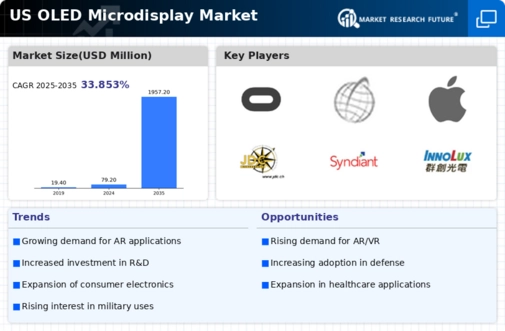Expansion of the Gaming Industry
The expansion of the gaming industry is significantly influencing the oled microdisplay market. With the increasing popularity of immersive gaming experiences, there is a growing need for high-quality displays that can deliver stunning visuals. The gaming market in the US is expected to surpass $200 billion by 2026, with a notable shift towards devices that utilize oled microdisplays. These displays provide gamers with enhanced contrast and faster response times, which are critical for competitive gaming. As the gaming industry continues to evolve, the demand for oled microdisplays is likely to increase, further solidifying their position in the market.
Growing Interest in Wearable Technology
The rise of wearable technology is significantly impacting the oled microdisplay market. As consumers increasingly seek compact and high-performance devices, manufacturers are turning to oled microdisplays for their lightweight and energy-efficient properties. The market for wearable devices is expected to reach $100 billion by 2026, with a substantial portion attributed to products utilizing oled microdisplays. This trend is particularly evident in fitness trackers and smartwatches, where display quality is paramount. The integration of oled microdisplays in these devices enhances user experience, thereby driving demand in the oled microdisplay market.
Rising Demand for High-Resolution Displays
The demand for high-resolution displays is a key factor driving the oled microdisplay market. As consumers and industries alike seek superior visual experiences, the need for displays that offer high pixel density and vibrant colors has become paramount. The market for high-resolution displays is projected to grow by 20% annually, with oled microdisplays being at the forefront of this trend. Applications in gaming, virtual reality, and professional visualization are particularly driving this demand. The ability of oled microdisplays to deliver exceptional image quality positions them as a preferred choice in the evolving landscape of display technology.
Increased Investment in Research and Development
Investment in research and development (R&D) is a crucial driver for the oled microdisplay market. Companies are allocating significant resources to innovate and improve display technologies, which is essential for maintaining competitive advantage. In the US, R&D spending in the electronics sector has seen a steady increase, with estimates suggesting a growth of 8% annually. This investment is likely to lead to breakthroughs in display efficiency and performance, further propelling the oled microdisplay market. Enhanced R&D efforts are expected to yield new applications, particularly in sectors such as healthcare and automotive, where high-quality displays are increasingly required.
Technological Advancements in Display Technology
The oled microdisplay market is experiencing a surge due to rapid technological advancements in display technology. Innovations in manufacturing processes and materials have led to enhanced resolution and color accuracy, making oled microdisplays increasingly attractive for various applications. For instance, the introduction of new organic materials has improved the lifespan and performance of these displays. As a result, the market is projected to grow at a CAGR of approximately 15% over the next five years. This growth is driven by the increasing adoption of oled microdisplays in consumer electronics, such as smart glasses and head-mounted displays, which are gaining traction in the US market.





















Leave a Comment